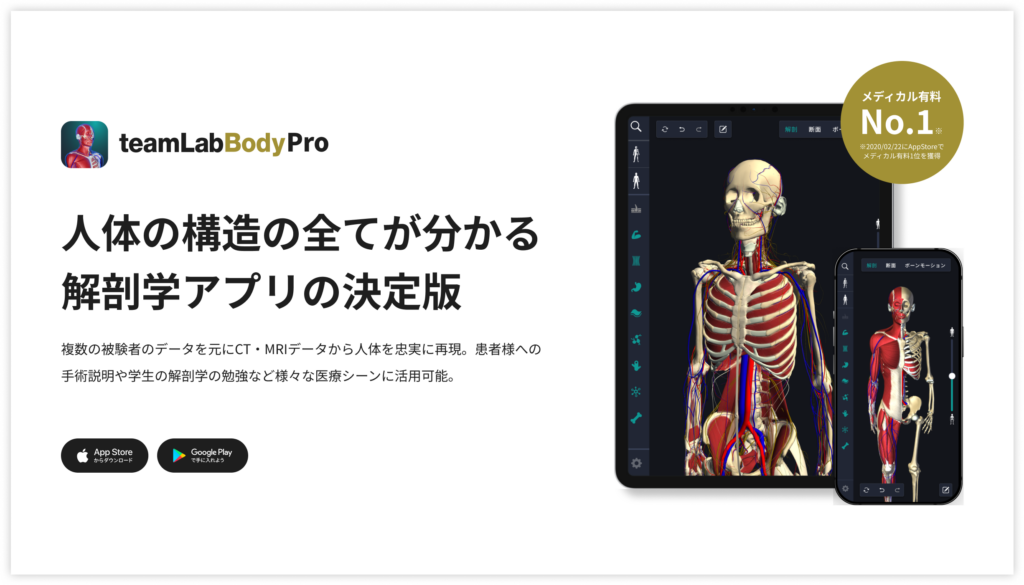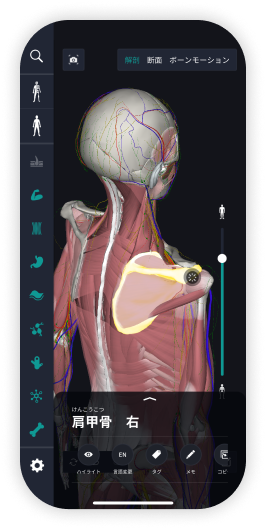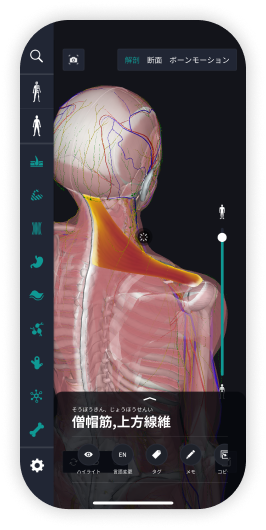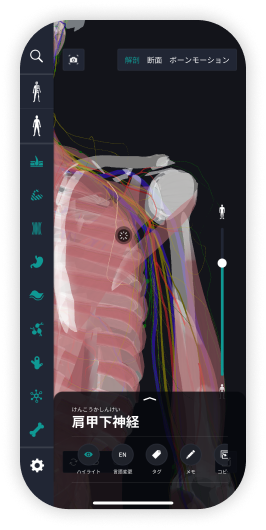beginning
In this article, I will explain effective study methods in human anatomy.
In human anatomy, it is necessary not only to memorize the names of various organs, muscles, and bones, but also to remember where they are located in the body. Therefore, it is necessary to learn as efficiently as possible.
This time, I'll explain how to study about “shoulder blades.”
teamLab Body Pro Free Download
A 3D anatomy app that shows all the structures of the human body
Download teamLab Body Pro here!

Learning using anatomy apps
In the anatomy application, you can view a selection of anatomy 3D models. In this model, there are various observation methods such as surfaces, cross-sections, and nervous systems.
1. Location of shoulder blades

The shoulder blades are located in the upper back of the human body and form part of the main structure of the shoulder joint.
There are symmetrical pairs of shoulder blades on the human back, and each is connected to the humerus bone (arm bone) and collarbone (bone at the base of the neck), and plays an important role in shoulder joint movement.
The shoulder blades have a triangular shape and have an inner edge (spine side) and an outer edge (shoulder side), and an upper corner and a lower corner. Specifically, it is located between the 2nd and 7th ribs.
Also, there are spines called scapula spines on the shoulder blades, and these spines divide the shoulder blades into upper and lower parts. By understanding these structures, you can learn more deeply the anatomy of the shoulder joint and back.
2. Constitutive muscles of shoulder blades

There are many muscles attached to the shoulder blades, and these muscles play an important role in shoulder stability and movement.
Typical constituent muscles of the scapula include the trapezius muscle, rhomboid muscle, levator scapula muscle, and serratus anterior muscle.
The trapezius muscle works to lift, rotate, and pull the shoulder blades inward. The rhomboid muscle pulls the shoulder blades inward and stabilizes the shoulder blades and spine.
The levator scapula muscle pulls the shoulder blades upward, and the serratus anterior muscle pulls the shoulder blades forward and helps fix the shoulder joint. These muscles work together to enable complex shoulder movements and play a role in maintaining shoulder blade stability.
3. Major nerve of scapula

The major nerves that control movement and sensation in the shoulder blades include the dorsal scapula nerve, thoracic nerve, and long thoracic nerve.
The dorsal scapula nerve mainly controls the rhomboid muscle and levator scapula muscle, which controls shoulder blade abduction and elevation movements. The thoracic dorsal nerve acts on the latissimus dorsi muscle and helps the shoulder to be inverted, extended, and internally rotated.
Meanwhile, the long thoracic nerve is supplied to the serratus anterior muscle and is responsible for stabilizing the shoulder blades. These nerves are critical to shoulder blade movement and function.
Therefore, understanding the anatomical pathways and suppliers of these nerves is very important for maintaining normal shoulder blade function. In particular, when there is shoulder or back pain or abnormalities, evaluating such neurological conditions can lead to accurate diagnosis and appropriate treatment.
Specific study methods using apps
I will explain specific study methods using human anatomy applications.
Check your past learning history and practice repeatedly
Here are the steps to check your anatomy learning history and practice iteratively effectively.
1. Check your learning history in the app
Reviewing your learning history with the application is an important step in effectively advancing anatomy learning. First, launch the app and go to the learning history section from the main menu. Many anatomy apps are designed to show your progress in the form of graphs and lists, so you can visually check which parts you've learned about and how much time you've spent. By using this data, you can understand which areas you have strengths in and where you need to spend more time and effort. We also recommend using a dedicated tag or notebook function to mark areas you are particularly weak at or where you need to relearn. Regularly checking your learning history and looking back on past learning content will lead to efficient review and deepening understanding.
2. Make a plan for iterative learning
Making an efficient repetitive learning plan based on learning history is extremely effective in promoting knowledge retention. First, identify weak points and areas where you need to relearn. Next, arrange these study items into a weekly or monthly calendar and create a specific study schedule. By proceeding in a planned manner, you can learn each part evenly and avoid packing in a large amount of information at once. Using a task management app or digital calendar to set study reminders is effective. Also, it's important to have the flexibility to regularly review progress and revise plans as needed. By having goals and proceeding with your studies in a planned manner, you can efficiently acquire anatomical knowledge.
3.Use 3D features to learn visually
By utilizing the 3D function, learning anatomy is easier to understand visually. The 3D model shows the structure of the human body three-dimensionally, and each part can be observed in detail. This makes it possible to intuitively grasp positional relationships between deep muscles and organs that are difficult to capture in a planar view. For example, you can learn even the smallest details by rotating specific muscles and bones and zooming in and out. Also, there are many apps that have the function of displaying cross-sectional views of each part using a 3D model, which is useful for deepening understanding of internal structures. This diversity of visual information helps with memory retention and improves immediate responsiveness in tests and practice situations. By utilizing the 3D function and learning visually, you can learn anatomy knowledge more deeply and efficiently.
Use the memo function concretely

Make notes so you don't forget the things and points you've noticed while studying. The memo function can be used for different purposes, such as inputting text, saving images, and writing memos. Tag your notes to make them easier to review later.
Test your learning regularly in the form of quizzes
Regularly testing what you've learned in a quiz format is a very effective way to anchor your anatomy knowledge. Quiz-style tests help you objectively grasp your level of understanding and areas you lack while repeating knowledge.
For example, by using a learning app to conduct quizzes every specific period, you can reconfirm what you've learned and strengthen your memory. There are a wide range of quiz formats, such as multiple choice questions, fill-in-the-blank questions, and short answer questions, and each helps understanding from a different angle and develops the ability to utilize various types of knowledge.
Get feedback
If possible, get feedback from other learners and experts. It helps you find your own gaps in understanding and areas for improvement. You can also keep yourself motivated to learn by regularly testing yourself. Feeling a sense of accomplishment and progress increases motivation for continuous learning.
summary
This time, I explained how to study “shoulder blades” using an application!
Thank you for reading this far.
I would be happy if reading this article helped you learn about anatomy.
Learning is a long, never-ending journey, but I sincerely wish you all the best. Let's continue to study together and work hard for the national exam!
Please look forward to the next blog.
teamLab Body Pro Free Download
A 3D anatomy app that shows all the structures of the human body
Download teamLab Body Pro here!





